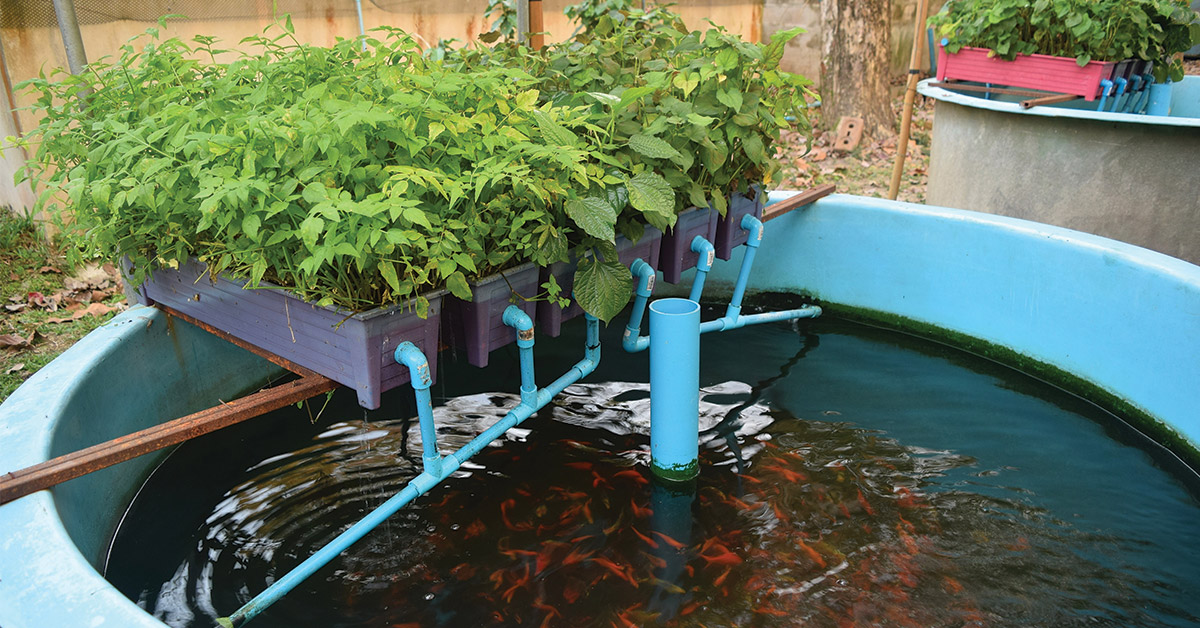In an aquaponic system, fish are the driving force behind plant growth. Their waste provides essential nutrients for plants, while plants and beneficial bacteria help maintain clean water for the fish. Keeping fish healthy is critical for a balanced system, and this requires proper feeding, regular water maintenance, and disease prevention.
In this guide, we’ll cover:
✅ Feeding strategies to ensure proper nutrition.
✅ Water management to maintain a stable environment.
✅ Disease prevention to keep your fish thriving.
Let’s dive in! 🐟🌿
1. Feeding Your Fish: Proper Nutrition for Growth and Health
Choosing the Right Fish Feed
The type of feed you choose depends on your fish species. Some fish are herbivores, some carnivores, and others are omnivores.
Fish Species Diet Type Common Feeds Tilapia Omnivore Pellets, duckweed, algae, kitchen scraps Trout Carnivore High-protein pellets, insects, small fish Catfish Omnivore Pellets, insects, algae Koi/Goldfish Omnivore Pellets, plants, fruits, vegetables📌 Key Considerations:
✔ Protein Content: Younger fish need higher protein (30-50%), while adults thrive on lower levels (25-35%).
✔ Balanced Diet: Include natural foods like duckweed, algae, or worms.
✔ Floating vs. Sinking Pellets: Choose based on fish species (surface feeders prefer floating pellets).
How Often and How Much to Feed
-
Feed small portions 2-3 times a day.
-
Fish should eat all the food in 2-5 minutes.
-
Overfeeding leads to ammonia spikes, which harm both fish and plants.
🚨 Warning: Uneaten food rots quickly, causing poor water quality. Always remove uneaten food after feeding.
2. Water Management: Keeping Conditions Stable
Maintaining good water quality is the most important factor in keeping fish healthy. Even minor imbalances can cause stress, disease, and even death.
Key Water Parameters to Monitor
Parameter Ideal Range Importance Temperature Species-dependent (Tilapia: 22-30°C, Trout: 10-18°C) Affects metabolism and growth pH 6.5 – 7.5 Controls nutrient availability Ammonia (NH₃/NH₄⁺) 0 – 0.5 ppm High levels are toxic to fish Nitrites (NO₂⁻) 0 ppm Even small amounts harm fish Nitrates (NO₃⁻) <40 ppm Essential for plants but too much stresses fish Dissolved Oxygen >5 ppm Low oxygen can suffocate fishRegular Water Changes
Even in a well-functioning aquaponic system, water changes are sometimes necessary to remove excess waste and maintain balance.
✅ When to do a water change:
-
If ammonia or nitrites exceed safe levels.
-
If nitrates are too high and plants can’t absorb them fast enough.
-
If fish are showing stress symptoms (gasping, lethargy, erratic swimming).
✅ How to do a water change properly:
-
Remove 10-20% of the water (never change too much at once!).
-
Replace with dechlorinated, temperature-matched water.
-
Avoid disturbing the beneficial bacteria in your filtration system.
📌 Pro Tip: Adding rainwater (if free of contaminants) can help maintain proper pH levels naturally!
3. Disease Prevention: Keeping Your Fish Healthy
Fish diseases can spread quickly and cause serious losses in aquaponic systems. The best way to prevent disease is through good system management and early detection.
Common Fish Diseases in Aquaponics
Disease Symptoms Causes Treatment Ich (White Spot Disease) White spots, rubbing against surfaces Poor water quality, stress Increase water temp, salt bath Fin Rot Fins appear ragged or torn Bacterial infection, dirty water Improve water quality, antibiotics if severe Fungal Infections White cotton-like growths Stress, injury, poor water conditions Salt treatment, antifungal meds Ammonia Poisoning Red gills, gasping for air, lethargy High ammonia levels Immediate water change, improve filtration Swim Bladder Disorder Fish swimming upside down Overfeeding, diet imbalance Fast the fish, adjust diet🚨 Early Detection Saves Fish!
Watch for unusual behavior, such as:
❌ Lethargy (low energy, staying in one place)
❌ Gasping at the surface (low oxygen levels)
❌ Erratic swimming (possible infection or stress)
4. Best Practices for Keeping Fish Healthy
✅ Maintain Stable Water Conditions
-
Test pH, ammonia, nitrites, and nitrates weekly.
-
Keep water temperature consistent based on species.
✅ Feed a Proper Diet
-
Provide high-quality feed with the right protein content.
-
Avoid overfeeding—feed only what fish eat in 2-5 minutes.
✅ Ensure Good Oxygen Levels
-
Use aeration systems (air pumps, bubblers) to maintain dissolved oxygen.
-
Avoid overcrowding—too many fish reduce oxygen levels quickly.
✅ Quarantine New Fish
-
New fish can introduce diseases or parasites into your system.
-
Keep new fish in a separate tank for 2 weeks before adding them.
✅ Clean Your System Regularly
-
Remove uneaten food and debris to prevent ammonia buildup.
-
Ensure filters and pumps are working properly.
✅ Handle Fish Gently
-
Use a soft net when moving fish.
-
Avoid sudden temperature or pH changes when transferring fish.
Conclusion: Healthy Fish = Thriving Aquaponics
Taking care of fish in an aquaponic system requires attention to feeding, water quality, and disease prevention. By monitoring key water parameters, feeding properly, and keeping an eye on fish behavior, you can ensure a balanced and productive ecosystem.
💡 Key Takeaways:
✔ Feed fish high-quality food in the right amounts.
✔ Maintain clean and stable water conditions.
✔ Watch for early signs of disease and take action quickly.
✔ Regular water changes and oxygenation are essential.
With proper care, your fish will stay healthy, your plants will grow strong, and your aquaponic system will thrive for years to come!
🐟🌱 What challenges have you faced in keeping fish healthy in aquaponics? Share your experience in the comments! ⬇️

Comments
No comments yet. Be the first to comment!
You must be logged in to comment. Login